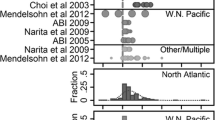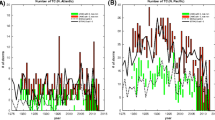Abstract
This paper estimates the damages from tropical cyclones (TCs) in the Southern Hemisphere under future climate change scenarios based on the historical TC records in Australia. From the best-track TC data, we examine the changes in frequency, intensity, and economic damage of the TCs that made landfall since 1970. From the detailed individual TC reports, damage estimates are constructed based on reported damages. We find that the TC frequency has significantly declined over time. The intensity, however, does not show a significant trend. Average damage per TC has declined significantly from 43 million AUD in the 1970s to 11 million in the 1990s. This paper finds that 1 % decrease in minimum central pressure leads to 32.7 % increase in economic damage, which is more than three times larger than that found in the US hurricane study with regards to maximum wind speeds. For future damage projections, characteristics of the 14,000 TCs generated under seven different AOGCM climate models are applied. All seven climate models predict a decrease in TC frequency in the Southern Hemisphere but intensity predictions vary. By the end of the twenty second century, changes in climate are expected to increase the TC damage under the MRI (\(+\)94 %), the MIROC (\(+\)73 %), and the CSIRO (\(+\)66 %) model due to increased intensity. However, TC damage is expected to fall under the GFDL (\(-\)92 %) and the CNRM (\(-\)85 %) model due to decreased intensity and frequency. Adaptation will be a key determinant of the future vulnerability to TCs in the Southern Hemisphere.





Similar content being viewed by others
Notes
According to the BOM, the number of intense TCs (Category 4 and 5) shows no appreciable trend over the period (BOM 2011a).
Table 1 Frequency, intensity, and damage of all landfalling cyclones since 1970 The report on TC Tracy states that it caused several hundreds of millions of dollars in 1974 dollar (BOM 2011a). Excluding the number of lives lost (65) and the number of people seriously injured (145), a conservative estimate of 200 million in 1974 dollars (0.32 % of the GDP at the time) is used for the analysis. This is approximately the value of the total number of houses destroyed, i.e., 70 % of the total houses in Darwin according to the report.
Total population of a town instead of population density is used as an explanatory variable since it is a better indicator of vulnerability by way of the number of houses destroyed or damaged.
The State dummies capture such factors as different income levels across the States.
The damage estimates are normalized to 2007 Australian dollars using the GDP deflator. Therefore, the analysis assumes the same rate of income growth in the future.
References
Australian Bureau of Statistics (ABS) (2010) Population projections, Australia, 2006–2101. Australian Government. Available at http://www.abs.gov.au
Australian Bureau of Statistics (ABS) (2012) Australian Census. Canberra, Australia. Available at http://www.abs.gov.au
Bureau of Meteorology (BOM) (2011a) Tropical cyclones. Australian Government. Available at http://www.bom.gov.au
Bureau of Meteorology (BOM) (2011b) ENSO wrap-up. Australian Government. Available at http://www.bom.gov.au/climate/enso/index.shtml
Cook GD, Nicholls MJ (2007) Estimation of tropical cyclone wind hazard for Darwin: comparison with two other locations and the Australian wind loading code. J Appl Meteorol Clim 48:2331–2340
Durbin J, Watson GS (1951) Testing for serial correlation in least squares regression. Biometrika 37:409–428
Elsner JB, Kossin JP, Jagger TH (2008) The increasing intensity of the strongest tropical cyclones. Nature 455:92–95
Emanuel K (1987) The dependence of hurricane intensity on climate. Nature 326:483–485
Emanuel K (2005) Increasing destructiveness of tropical cyclones over the past 30 years. Nature 436:686–688
Emanuel K (2008) The hurricane-climate connection. Bull Am Meteorol Soc 89:ES10–ES20
Emanuel K (2011) Global warming effects on US hurricane damage. Weather Clim Soc 3:261–268
Emanuel K (2013) Increased global tropical cyclone activity from global warming: results of downscaling CMIP5 climate models. Presented at the international summit on hurricanes and climate change, Kos, Greece
Emanuel K, Sundararajan R, Williams J (2008) Hurricanes and global warming: results from downscaling IPCC AR4 simulations. Bull Am Meteorol Soc 89:347–367
Garnaut R (2010) Garnaut climate change review. http://www.garnautreview.org.au/domino/Web_Notes/Garnaut/garnautweb.html
Hallegate S (2007) The use of synthetic hurricane tracks in risk analysis and climate change damage assessment. J Appl Meteorol Clim 46:1956–1966
Hansen J, Sato M (2006) Global temperature change. Proc Natl Sci Acad USA 103:14288–14293
Hansen J, Sato M, Reudy R (2012) Perception of climate change. Proc Natl Sci Acad USA. doi:10.1073/pnas.1205276109
Holland GJ (1997) The maximum potential intensity of tropical cyclones. J Atmos Sci 54:2519–2541
Intergovernmental Panel on Climate Change (IPCC) (2001) Climate shange 2001: the scientific basis. Cambridge University Press, Cambridge
Intergovernmental Panel on Climate Change (IPCC) (2007) Climate change 2007: the physical science basis. Cambridge University Press, Cambridge
Intergovernmental Panel on Climate Change (IPCC) (2012) Managing the risks of extreme events and disasters to advance climate change adaptation. Cambridge University Press, Cambridge, UK, A special report of working groups I and II of the Intergovernmental Panel on Climate Change, pp 582
Keeling CD, Piper SC, Bacastow RB, Wahlen M, Whorf TP, Heimann M, Meijer HA (2005) Atmospheric \(\text{ CO }_{2}\) and \(^{13}\text{ CO }_{2}\) exchange with the terrestrial biosphere and oceans from 1978 to 2000: observations and carbon cycle implications. In: Ehleringer JR, Cerling TE, Dearing MD (eds) A history of atmospheric \(\text{ CO }_{2}\) and its effects on plants, animals, and ecosystems. Springer, New York, pp 83–113
Kossin JP, Knapp KR, Vimont DJ, Murnane RJ, Harper BA (2007) A globally consistent reanalysis of hurricane variability and trends. Geophys Res Lett 34:L04815
Knutson TR, McBride JL, Chan J, Emanuel K, Holland G, Landsea C, Held I, Kossin JP, Srivastava AK, Sugi M (2010) Tropical cyclones and climate change. Nat Geosci 3:157–163
Koenker R, Bassett G (1978) Regression quantiles. Econometrica 46:33–50
Landsea CW, Harper BA, Hoarau K, Knaff JA (2006) Can we detect trends in extreme tropical cyclones? Science 313:452–454
Landsea C, Vecchi GA, Bengtsson L, Knutson TR (2009) Impact of duration thresholds on Atlantic tropical cyclone counts. J Clim 23:2508–2519
Meat and Livestock Australia (MLA) (2012) Prices and markets. North Sydney, Australia. Available at http://www.mla.com.au/Prices-and-markets
Mendelsohn R, Emanuel K, Chonabayashi S, Bakkenshen L (2012) The impact of climate change on global tropical cyclone damage. Nat Clim Chang 2:205–209
Murnane RJ, Elsner JB (2012) Maximum wind speeds and US hurricane losses. Geophys Res Lett 39:L16707. doi:10.1029/2012GL052740
Nakicenovic N, Davidson O, Davis G et al (2000) Emissions scenarios. A special report of working group III of the Intergovernmental Panel on Climate Change. IPCC, Geneva
National Oceanic Atmospheric Administration (NOAA) (2009) Tropical cyclone reports. National Hurricane Center, NOAA
Nordhaus W (2010) The economics of hurricanes and implications of global warming. Clim Chang Econ 1:1–24
Pielke RA, Gratz J, Landsea CW, Collins D, Saunders MA, Musulin R (2008) Normalized hurricane damages in the United States: 1900–2005. Nat Hazards Rev 9:29–42
Rahmstorf S, Coumou D (2011) Increase of extreme events in a warming world. Proc Natl Sci Acad USA 108:17905–17909
Real Estate Institute of Australia (REIA) (2012) REIA Datacube. ACT, Australia
Seo SN (2012) Decision making under climate risks: an analysis of sub-Saharan farmers’ adaptation behaviors. Weather Clim Soc 4:285–299
Sydney Morning Herald (SMH) (2011) Yasi spares life, crushes communities. SMH (Feb 3, 2011). http://news.smh.com.au/breaking-news-national/yasi-spares-life-crushes-communities-20110203-1ae14.html
Somers J (1992) Building wealth through investment property. Somerset Financial Services, Australia
Tebaldi C, Hayhoe K, Arblaster JM, Meehl GE (2007) Going to the extremes: an intercomparison of model-simulated historical and future changes in extreme events. Clim Chang 82:233–234
United States General Accounting Office (GAO) (2003) Flood insurance: challenges facing the national flood insurance program. GAO, Washington, DC #/Find\_Data/Products\_and\_Data\_Available/GTOPO30
United States Geological Survey (USGS) (2004) Global 30 arc second elevation data. 20 USGS National Mapping Division, EROS Data Centre, USGS. Available at http://eros.usgs.gov
Vecchi GA, Knutson TR (2008) On estimates of historical North Atlantic tropical cyclone activity. J Clim 21:3580–3600
Webster PJ, Holland GJ, Curry JA, Chang HR (2005) Changes in tropical cyclone number, duration, and intensity in a warming environment. Science 309:1844–1846
White H (1980) A heteroscedasticity-consistent covariance matrix estimator and a direct test for Heteroscedasticity. Econometrica 48:817–838
World Bank (2012) World Bank Data: Australia. World Bank. Washington, DC, USA. Available at http://data.worldbank.org/country/australia
Acknowledgments
I would like to express my gratitude to Robert Mendelsohn and Laura Bakkensen for the comments on various drafts and to Kerry Emanuel for the advice on future TC projections. An earlier version was presented at the 4th International Summit on Hurricanes and Climate Change held in Kos, Greece on June 15th, 2013. I am thankful to the participants’ comments and James Elsner in particular. This project was funded by the International Research Office at the University of Sydney.
Author information
Authors and Affiliations
Corresponding author
Rights and permissions
About this article
Cite this article
Seo, S.N. Estimating Tropical Cyclone Damages Under Climate Change in the Southern Hemisphere Using Reported Damages. Environ Resource Econ 58, 473–490 (2014). https://doi.org/10.1007/s10640-013-9744-x
Accepted:
Published:
Issue Date:
DOI: https://doi.org/10.1007/s10640-013-9744-x




